Six-Day War Day 3 — “The Temple Mount is in Our Hands”
Reliving Israel’s Victory with a 6-Part Series of the Day-to-Day Action
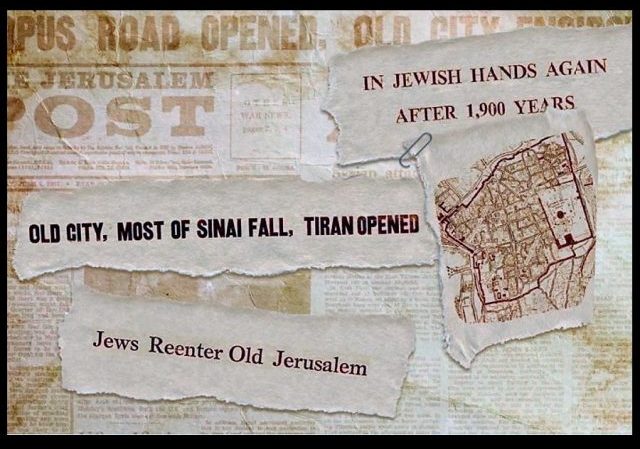
Note: This is the third in our daily re-created coverage of the Six-Day War, which will run through Saturday, June 10. Prior posts: 50th Anniversary of Six-Day War: The Eve of War; Six-Day War Day 1 — War Begins; Six-Day War Day 2: At the Gates of Jerusalem’s Old City.
Israel’s armed forces are emerging triumphant in a lightning war which today saw the Egyptians defeated and forced back to the banks of the Suez Canal.
The blockade of the Gulf of Aqaba has also been broken with the Israel’s Navy now holding Sharm el-Sheikh and reopening the Straits of Tiran to Israeli shipping. This afternoon, Egypt’s President Nasser also surrendered Gaza.
Israel has reopened the #StraitsofTiran, the key political objective we had set ourselves. #sixdaywar
— Levi Eshkol on TW (@EshkolTweets) June 7, 2017
IDF reports that Sharm-el-Sheikh has fallen. Intenational waterway is now open once again (pls excuse typos)
— Moshe Dayan on TW (@MosheDayan67) June 7, 2017
Judea and Samaria of the Bible—the birthplace of the Jewish people, and until 1948 a place where Jews had a continuous presence—today came into Israeli hands after the Israel Defense Forces (IDF) captured the major cities of Bethlehem, Jericho, Tulkarem, and Nablus.
The ancient Old City of Jerusalem is also now under Israel’s control.
At day’s end, snipers are still firing in the Old City; the IDF will need to mop up these remaining pockets of Jordanian resistance.
But, aside from that, the battle on the eastern front is now over.
A string of military victories
Jordan’s army—which Israel had once thought was “unbeatable”—is now shattered and its morale completely crushed.
Today, Jordan sought a cease-fire from Israel and this evening, King Hussein reportedly received it. (Years from now, the King will probably admit that believing the bogus tidings of victory from his Egyptian ally two days ago was one of the biggest blunders that he ever made).
But Egypt, virtually run out of the Sinai Desert in today’s battles, is reportedly refusing to give up the fight and is now planning to regroup its forces for the next round.
The war is also heating up in the north.
The greater part of four Arab air forces has been destroyed, but on the northern front there’s some indication that Syrian forces are advancing. Israel has considered it to be the lesser front, but in the days ahead the IDF will undoubtedly need to turn its attention there to relieve the communities within range of the relentless barrage of Syrian artillery.
7.6.67 Reports coming in of continuous shelling in the North despite victories elsewhere in #Israel.
— Foreign Journalist (@MEjournalist67) June 7, 2017
The Syrian shelling continues, yet the IDF is not moving. We hear of success elsewhere but nothing here. I dont understand.
— Kibbutz Volunteer'67 (@KarinBerg67) June 7, 2017
Seems like we're being relocated from Eygpt to the #Golan. Shipping out tomorrow morning and waiting further instructions.
— IDF Reservist '67 (@YoavSadon) June 7, 2017
Israel’s military victories in the Sinai have been spectacular (IDF forces there are under the command of major-general Yishayahu “Shaike” Gavish). But as even Gavish acknowledges, it’s Colonel Motta Gur’s paratroopers of the 55th Brigade who have deservingly “stolen the show from the southern command.”
Today the paratroopers took control of the Old City and Temple Mount, liberating Judaism’s most holiest sites from an illegal Jordanian occupation.
In the advance no artillery, tanks or aircraft were used in order to prevent damage to the historic and sacred sites. There were reportedly some Israeli casualties from sniper fire, but most of the Jordanian armed forces had already retreated and there was no major battle.
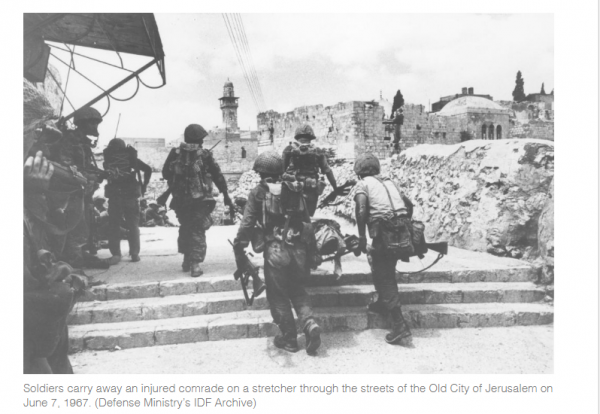
The fight was comparatively easy; retaking the Old City took only a matter of minutes.
This is a profound moment in Jewish history—a 2,000 year old dream has become a reality. For the first time in 19 years since the state’s independence, Israelis and Jews worldwide can go to pray at the Western Wall/the Kotel and (hopefully) on the Temple Mount/Har HaBayit too.
Dayan: “Israel has achieved its objectives”
In a statement released today, Defense Minister Moshe Dayan stated:
Israel has achieved the objectives for which she had gone to war.”
Chief of Staff Lieutenant General Yitzhak Rabin echoed the sentiment, providing further detail:
We have caused the total disruption to the Egyptian army and delivered a great blow to the Jordanian army. We have taken most of the relevant parts of the Sinai Peninsula, and practically all of the West Bank of the Jordan is in our hands. All this was done by Israeli defense forces alone, with what we have here, without anything or anybody else.”

[The Washington Post | Front Page | June 7, 1967]
Cairo Radio today continues to call on the nation to “teach the Israelis a lesion—drive them out of the Holy Land.”
But colleagues based on Cairo tell us that people are also beginning to grasp that Israel has “transitioned from serious danger to successful resistance.” No one seems ready to believe the worst, but they’re catching on that “things are not going well” for their side.
We’ve been told that the residents passed the night in darkness on account of the blackout, with little news getting through.
Their spirits were reportedly buoyed somewhat and they took comfort from a few reports of “exceptional bravery” on the front and the “complete annihilation of Israeli paratroopers” (Perhaps it was a reference to the fierce and bloody trench warfare at Ammunition Hill which we reported about yesterday. As we noted, the Jordanians did fight valiantly; to commemorate their heroism, the victorious paratroopers of the 55th Brigade built a memorial in their honor).
But for the most part the mood in Cairo is somber: one Egyptian man, feeling particularly gloomy, reportedly insisted that Israel will soon occupy Cairo using its female troops to add further to the humiliation. Our colleagues noted that this set up an “amusing prospect of armed young Israeli women in sandals swarming west on Gisr El Swais.”

[Credit: The Washington Post | June 7, 1967]
The decision to retake the Old City
Yesterday, looking down on the Old City from the strategic vantage point on Mount Scopus, the IDF planned how to best strike Jordanian forces in the Old City.

Paratroopers Ready to Break Into the Old City | Credit: Times of Israel
So there was preparation involved over the last 48 hours, but during this time the General Staff was also under firm orders not to enter the place.
Only early this morning did Gur finally get the call from Central Command Chief Uzi Narkiss to begin the operation; Dayan had given the go-ahead.
In the months and years ahead, some will probably conclude that the decision to take the Old City today was made solely by Dayan.
But this would be inaccurate.
The reality is that Dayan had prior authorization from the government to take the action that he thought appropriate. As Prime Minister Levi Eshkol noted at the security cabinet meeting last night:
We will not go into the Old City tonight…If political developments require it, the defense minister is entitled to order the IDF to enter the Old City.”
This is exactly what happened, in Dayan’s mind.
Tipped off to a potential UN-declared cease fire, he ordered Gur’s Paratroopers Brigade to move in—lest Israel “miss its chance” to regain control of Jewish heritage.
We’re glad he took the opportunity and are mindful that things might have gone down very differently.
Early this morning, as Gur prepared his men, PM Eshkol reportedly met with the cabinet in the Knesset bomb shelter. The ministers decided to contact King Hussein one last time. A letter was sent offering to forgo liberating the Old City if Jordan agreed to peace talks.
The King never answered, and the rest is history.
Begin woke me at 4:00 am. convinced we must take Old City now, otherwise we may never have the opportunity again. Dayan concurs. #sixdaywar
— Levi Eshkol on TW (@EshkolTweets) June 7, 2017
At 9:00 am this morning, 28th Iyar, 5727 (June 7, 1967) #Israel's government resolved to restore the #westernwall to the #Jewish people.
— Levi Eshkol on TW (@EshkolTweets) June 7, 2017
Gur: “The Temple Mount is in our hands”
Late this morning, Israeli Army radio broadcast a message that will no doubt go down in the annals of Jewish history.
It’s a riveting recording (listen or read the transcript here) of the paratroopers entering the Old City, which will now be preserved for future generations to appreciate and cherish.
It’s just a few minutes long and parts of it are a bit patchy, but you can distinctly hear the sounds of gunfire, and the footsteps of the first units who breached the Old City moving through Lions Gate, drawing closer and closer to the Temple Mount—Judaism’s holy of holies.
The battle-hardened military leaders—Central Command Chief Uzi Narkiss and Colonel Motta Gur—give instructions on where to go.
Then, in three words of modern Hebrew that will surely soon be regarded as among the most important ever uttered in the history of the Jewish people, Gur announces on the army wireless “Har HaBayit B’yadenu!”—“The Temple Mount is in our hands!”.
"The Temple Mount is in our hands" #SixDayWar #Israel #History #JerusalemJubilee #Jerusalem50 pic.twitter.com/TeeETovQNi
— Six Day War Quotes (@SixDayWarQuotes) June 7, 2017
The soldiers recite the ‘Shehechianu’ blessing—(Translation: Blessed art Thou L-rd G-d King of the Universe who has sustained us and kept us and has brought us to this day). One of the commanders says,
I’m walking right now down the steps towards the Western Wall. I’m not a religious man, I never have been, but this is the Western Wall and I’m touching the stones of the Western Wall”.
Toward the end of the recording, a triumphant Brigadier General Rabbi Shlomo Goren, recites the memorial prayer and sounds the shofar.

You can clearly discern the soldiers weeping with sorrow over their fallen comrades.
With soldiers sobbing and the sound of gunfire still in the background, the recoding concludes with Goren rendering a revised version of the traditional blessing, “Next Year in Jerusalem”. He says: “Le-shana HA’ZOT b’Yerushalayim ha-b’nuya! be-yerushalayim ha-atika!” (Translation: THIS year in a rebuilt Jerusalem! In the Jerusalem of old!).
Here's a transcript of the IDF radio recording of the capture of the Old City. Heady stuff.https://t.co/4QIU7pJhFm pic.twitter.com/kcPvUIlK0p
— Foreign Journalist (@MEjournalist67) June 7, 2017
Images that’ll be etched in history
Throughout the day, Israeli soldiers and army officials arrived at the Old City:
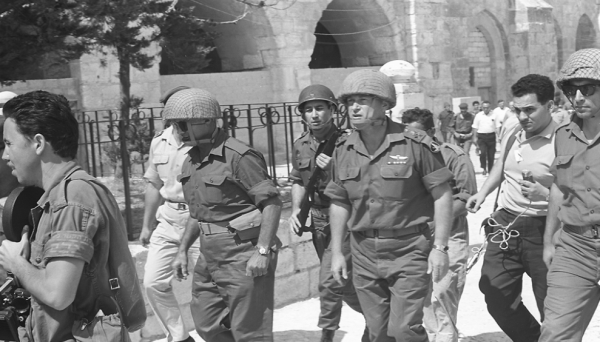
[Chief of Staff Yitzhak Rabin, Major-General Rehavam Ze’evi, Defense Minister Moshe Dayan march to the Western Wall | June 7, 1967]
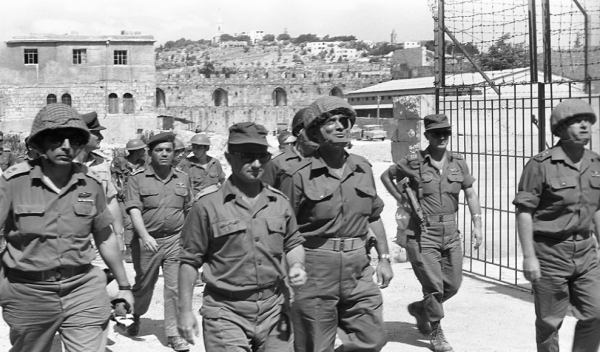
[Rabin, Dayan, and Central Command Chief Uzi Narkiss in the Old City | June 7, 1967]
We had a chance to speak with one of the commanders of the Jerusalem Brigade, which entered the Old City this morning through the Dung Gate. He had been born there and was 16 years old when he—along with every last Jew who lived in the ancient Jewish Quarter—was expelled by Jordan in 1948.
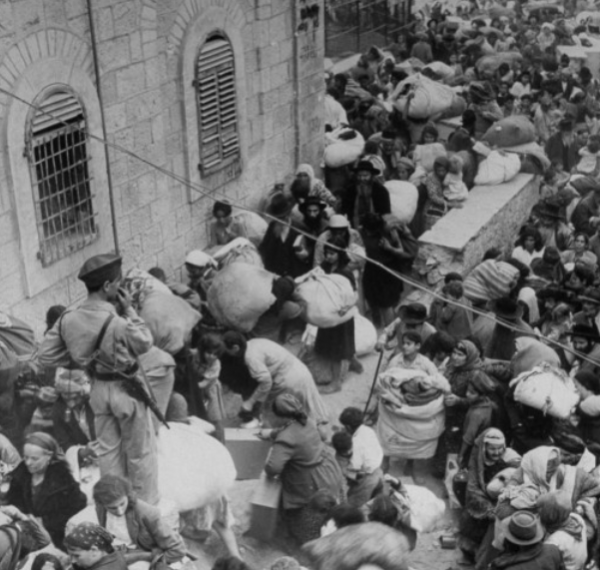
Jews Forced tp Leave Jordanian-controlled east Jerusalem | Credit: IsraelMatzav
Returning today to the place of his birth was an experience that he said he’d treasure for the rest of his life.
Below are some of the “pictures that will be soon be seen around the world”. They’re images capturing Israel and the Jewish people at their most triumphant moment. Many of them will certainly become famous pictures in modern Jewish history. (Among our favorites are those portraying the Chief Military Rabbi, Major General Shlomo Goren, organizing prayers at the Western Wall and the Temple Mount for the troops who freed the city).
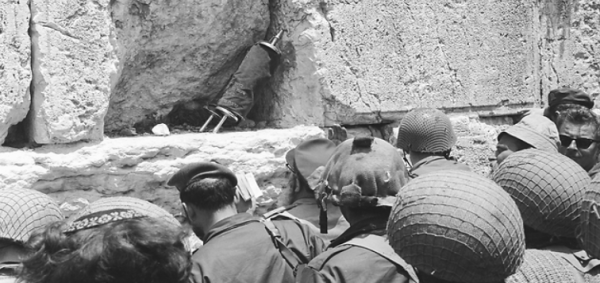
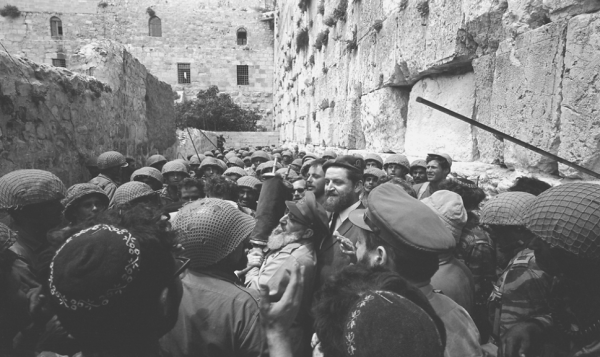

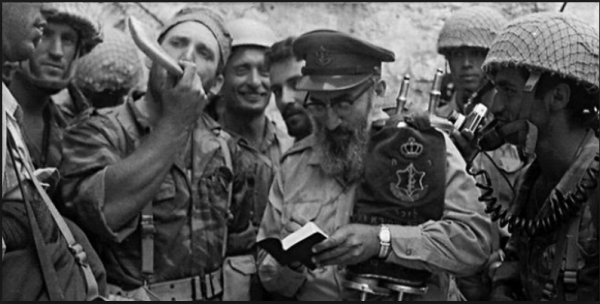
Chief Military Rabbi Goren at the Western Wall | June 7, 1967 | Credit: BreakingIsraelNews
But there are also photos that show a different side to the Battle for Jerusalem, not only the joy and euphoria but also the pain and fatigue of the paratroopers (who lost nearly 100 men in the last two days of combat to retake the city). Their sacrifices should never be “papered over with collective glee”:
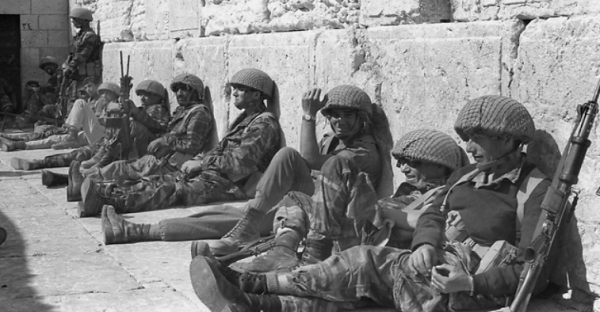
Three paratroopers at the Wall, one iconic photo
This morning, we saw one talented photographer actually get down on the ground, in the narrow passageway between the Western Wall and the homes abutting it, to take a snapshot that’ll undoubtedly become an iconic image:
![]()
In it, three battle-weary paratroopers gaze at their surroundings—the stones of the Western Wall (the Kotel)—in awe and stunned amazement.
Intrigued, we ended up interviewing the photographer—David Rubinger—and the three soldiers who were thrown together on this fateful day.
Rubinger told us that he was covering the war on the southern front at El-Arish in the Sinai (see Monday’s post) but rushed to Jerusalem when he learned that the IDF was planning a retaliatory strike on Jordanian forces.
He was able to join the paratroopers, arriving with them in time to take the first photos of Israeli troops at Judaism’s sacred site.
Rubinger told us:
I didn’t have any great feeling for Jerusalem. I just wanted to be the first with the photographs. There [is] still some sniping going on…When I got [here], it was very emotional. Everyone around me was crying…I think there was such euphoria because in the weeks before the war there was a sense of doom. The national stadium was prepared for 40,000 graves and even if we thought we might win, it would be costly victory. The humor before the war was very dark. ‘Would the last person to leave please turn out the lights’”.
We learned that the three soldiers were Zion Karasanti (24), Yitzhak Yifat (24), and Haim Oshri (23). All three were mobilized as reservists, joining their unit (the 3rd company of the 66th Battalion of the Paratrooper’s Brigade’s reserve force—55th Brigade) which was already in combat.
They said that they engaged in the hard-fought battle yesterday at Ammunition Hill, where they eventually overran Jordanian forces. Then they made their way to the Old City. They had never seen the Western Wall, so they didn’t immediately recognize where they were standing.
For each of them, and so many others—religious or not—it was an unforgettable, astonishing moment.
7.6.67 Now at #westernwall. Amazing scenes of emotion from battle-hardened soldiers. This moment, this place, really mean something to them.
— Foreign Journalist (@MEjournalist67) June 7, 2017
Amazing news! #Jerusalem is whole once more. Can't express how meaningful this is, and I'm not religious at all! #MazelTov #SixDayWar #OTD
— Jerusalem Homemaker (@RikkiSadon67) June 7, 2017
Dancing and singing in the streets with a new version of “Jerusalem of Gold”
On this third day of the war there is joy and laughter on Jerusalem’s streets. Emotions have been running wild—there’s a mixture of laughter, crying, and a lot of hugging.
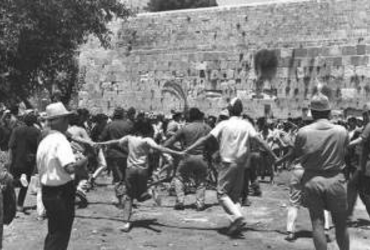
At one point, in front of the Western Wall, a group of paratroopers started an impromptu sing-along of renowned musician and poet Naomi Shemer’s famous song “Jerusalem of Gold”. Inspired by a Basque lullaby, it poignantly describes the Jewish people’s longing to return to a united Jerusalem.
Shemer composed the song just a few weeks ago, when Jerusalem Mayor Teddy Kollek asked that she write one in honor of the city to be played at the Israeli Song Festival on Independence Day.
Since then, the song has struck a chord with Israelis, so it’s not surprising that the paratroopers would choose it.
But when Shemer heard that the troops were singing her song at the Wall she reportedly quickly jotted down words for a new verse, replacing the lines “How have the wells of water dried out” and “There is no command of the Temple Mount” with “The wells of water have returned” and “A shofar [ram’s horn] calls out on the Temple Mount.”
Shemer arrived at the newly liberated Western Wall this evening and sang the song with the Nachal Brigade choir, along with the new verse.
We have no doubt that Shemer’s revised song—celebrating today’s milestone in the history of Israel and the Jewish people—will become the country’s new unofficial anthem and among the most famous in modern Jewish history.
Soon it will surely be sung in English and in many other languages:
It’s such a terrific song that we’re sure there will be some popular renditions created in the future:
Troubling Rumors about the Temple Mount
During his visit to the Old City today, Defense Minister General Moshe Dayan released an important statement:
This morning, the Israel Defense Forces liberated Jerusalem. We have united Jerusalem, the divided capital of Israel. We have returned to the holiest of our holy places, never to part from it again. To our Arab neighbors we extend, also at this hour—and with added emphasis at this hour—our hand in peace. And to our Christian and Muslim fellow citizens, we solemnly promise full religious freedom and rights. We did not come to Jerusalem for the sake of other peoples’ holy places, and not to interfere with the adherents of other faiths, but in order to safeguard its entirety and to live here together with others in unity.”
went to the Old City to survey the situation. a great moment of national achievement and personal satisfaction. #sixdaywar pic.twitter.com/p4vEUxSKjE
— Moshe Dayan on TW (@MosheDayan67) June 7, 2017
Israel captures Temple Mount/Western Wall. Reaches out for #peace. #sixdaywar #religion #Jerusalem pic.twitter.com/vhckixvxhu
— Six Day War Quotes (@SixDayWarQuotes) June 7, 2017
It was a fine speech.
"No harm…shall come to the place sacred to all religions."@EshkolTweets #WednesdayWisdom #SixDayWar #OTD pic.twitter.com/O9EUYGjKPw
— Six Day War Quotes (@SixDayWarQuotes) June 7, 2017
The battle done, Jerusalem's holy sites now in Israel's hands. Have instructed that each site be placed under jurisdiction of its own clergy
— Levi Eshkol on TW (@EshkolTweets) June 7, 2017
But today when a flag was hoisted over the conquered Temple Mount, we’re told that Dayan ordered to have it quickly taken down. Troubling rumors are now circulating that Dayan also plans to return the administration of the Temple Mount/Har HaBayit—the holiest of holies—to the Jordanian and Muslim waqf authorities.
Is Dayan really planning at the moment of Israel and the Jewish people’s victory to concede sovereignty over the Temple Mount—Judaism’s holiest site?
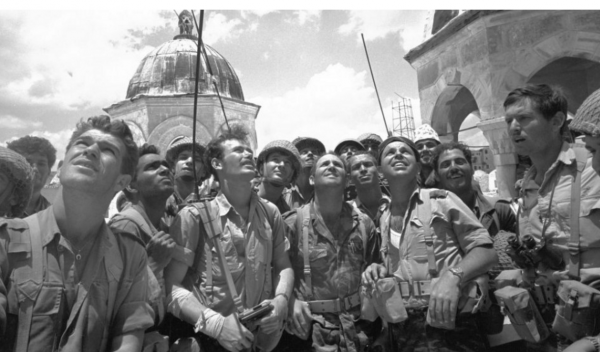
[Paratroopers arrive on Temple Mount | June 7, 1967]
Surely Dayan recalls that Jordan illegally and immorally denied Jews the right to worship at their holy sites—a shameless violation of the 1949 armistice agreement and basic respect for religious freedom.
As the IDF makes its way through the now liberated Old City, it’s also becoming painfully clear that for the past nineteen years Jordan didn’t just evict the Jews. It also spent its rule looting, ransacking, befouling, and dynamiting every last vestige of Jewish heritage.
Thus far, nearly 30 synagogues have been found vandalized, damaged, or even completely destroyed (the historic Porath Yosef, Hurva, and Tiferet Israel synagogues are in ruins). The famous Yohanan ben Zakkai Synagogue is devastated from within and stands now only as a shell. The synagogue founded by the great biblical scholar Nachmanides in 1267 is also a wreck.
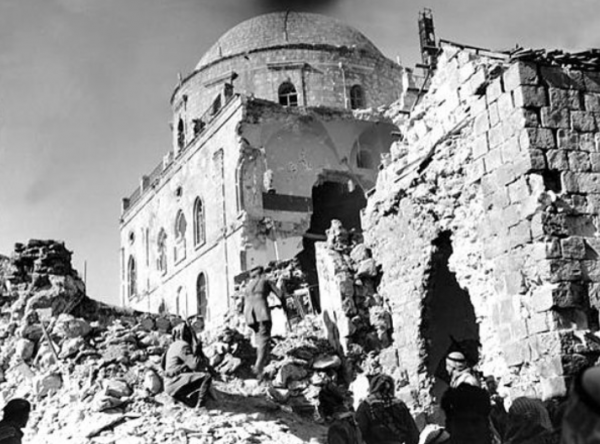
Destruction of Tefere Yisrael Synagogue, 1948
We’re hearing reports that the hallowed Jewish cemetery on the Mount of Olives—Judaism’s oldest and holiest—has suffered a similar fate, with graves ripped open and bones scattered, and hundreds of tombstones smashed or removed.
Walking through the Jewish Quarter today and seeing it so thoroughly destroyed, many recalled that the place looked like Stalingrad or Berlin after World War II.
So today marks the end of nearly two decades of this deplorable and unlawful Jordanian oppression against Jews in the Holy City. Does Dayan truly believe that the Jordanians or the waqf deserve any of our spontaneous concessions?
Maybe returning the Temple Mount won’t result in a complete abrogation of non-Muslim rights at the sacred place. But let’s not fool ourselves into thinking that the Jews will be treated any more decently on the site than they have in the past.
Our presence on the Mount in restricted numbers may now be grudgingly tolerated. But neither the Jordanians nor the waqf will ever allow us to worship there freely. Soon enough, they’ll probably also challenge our attachment to the Western Wall too.
So we hope that Dayan will soon come to his senses.
Conclusion
It’s hard to believe that just two days ago there was an atmosphere of catastrophe in the country—an anxiety, panic and uncertainty that gripped not only the public but Israel’s leaders too.
It’s clear that the government wanted diplomacy to work, but the Jewish state found itself isolated and “surrounded by enemies baying for Jewish blood”. For weeks, its Arab neighbors were backing up their bellicose words with aggressive deeds.
So the Israelis rightly “decided that they wouldn’t sit still for it.”
There can be no ambiguity about the Arabs’ annihilationist goals. But what’s happened instead is a “victory on a biblical scale”—a victory that today has astonished Israelis as much as it has “shocked the world.”
Bottom line: Sixty hours ago Israel acted in self-defense. Now, after a 2,000 years hiatus, Jewish forces have brought Jerusalem “back to Jewish sovereignty”.
Today is the 50th anniversary of the reunification of #Jerusalem! #AmYisraelChai #Zionism #Israel #MazelTov #sixdaywar @Tweeting67
— Chaim Weizmann on TW (@WeizmannTweets) June 7, 2017
h/t: Jewish Virtual Library; The Jerusalem Post; Honest Reporting; Jerusalem Center for Public Affairs.
Miriam F. Elman is an Associate Professor of Political Science and the Robert D. McClure Professor of Teaching Excellence at the Maxwell School of Citizenship & Public Affairs, Syracuse University. She is the editor of five books and the author of over 60 journal articles, book chapters, and government reports on topics related to international and national security, religion and politics, and the Israeli-Palestinian conflict. She also frequently speaks and writes on the Boycott, Divestment, and Sanctions (BDS) anti-Israel movement. Follow her on Twitter @MiriamElman
 DONATE
DONATE
Donations tax deductible
to the full extent allowed by law.








Comments
I don’t believe it. It’s a face-saving myth put out after the fact, just like Rabin’s “nervous breakdown” to cover up his drunk. If Dayan were so concerned about the Jewish heritage he wouldn’t have rushed to give it all away as soon as the war was over. The truth is that he wanted nothing to do with Judaism or its heritage. The Temple Mount meant nothing at all to him — less than nothing; he gave it to the Waqf the minute he could find them. Nor did Hevron mean anything to him, which is why he chased down its fleeing Arab population and persuaded them to come back and become the Jew-killing thorn in Israel’s side that they’ve been for the last 50 years.